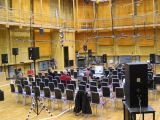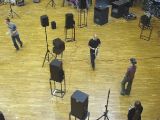The following post is a compilation of Auditory Illusions
Terminology
Perception Classification:
An auditory illusion can be classified into two categories based on the perception generated
1. Psychoacoustic Auditory Illusions
2. Psychophysic Auditory Illusions
1. Psychoacoustic Auditory Illusion
Psychoacoustic auditory illusions are complex sounds physically constructed to create frequency, spectral, rhythmic and dynamic ambiguity. This can be exemplified by the rhythmic configuration of the Risset Pattern (Risset 1972) or the tonal structures of Shepard Tones (Shepard 1964).
2. Psychophysic Auditory Illusion
Psychophysical auditory illusions are predominantly approached from the psychological environment examining sensory strengths and not intensely focused on the complex physical structure of the sound. Rather, they focus on the alternative perceptual response to sound targeted at the extremes of auditory sensory capacity. Superficially, the psychophysical illusion may not be as physically perplexing as the psychoacoustic illusion. However, the psychophysical illusions are still classified as an auditory illusion as they exploit the auditory senses’ ability to generate an alternate perception to the physical composite of the sound. Examples of the Psychophysical auditory illusion include those developed by Diana Deutsch, such as the Octave Illusion
Generation Classification:
An auditory illusion can be classified into two categories based on the structure of the stimuli:
1. Transmission Based Auditory Illusions
2. Construction Based Auditory Illusions
1. Transmission Based
Illusions that are dependent on the transmission of sound to successfully generate the distorted perception.
2. Construction Based
Illusions that are generated through the physical construction of sound.
Illusions
1. Shepard Tone
The Shepard tone (Shepard, Journal of the Acoustical Society of America, 1964) is a Psychoacoustic Construction Based Auditory Illusion that distorts the perception of frequency, frequency motion and direction through the exploitation of phasing, close harmonic relationships and misdirection.
The Shepard tone generates the illusion of static motion - that is a sliding scalic pattern that appears to rise in frequency whilst remaining in the same expanse motionless, or appearing to simultaneously ascend and descend in frequency.
The illusion of static motion is generated by the precise manipulation of phasing and overlaying of frequencies at various degrees of the scalic pattern.
REFERENCE:
Shepard, Roger. 1964. "Circularity in Judgements of Relative Pitch", The journal of the Acoustical Society of America. 36(12):2346-2353.
Risset, Jean-Claude. 1972. Musical Acoustics. Paris: IRCAM.
Risset, Jean-Claude. 1986. "Pitch and rhythm paradoxes: Comments on 'Auditory paradox based on fractal waveform'", The journal of the Acoustical Society of America. 80(3):961-962.
Tenney, James. 1992. "For Ann (Rising)." In Selected Works 1961-1969. Artifact Recordings
Johnson, Roger. 1981. Scores: An Anthology of New Music. New York: Schirmer Books. 171.
2. Risset Pattern
The Risset Pattern (Risset, Journal of the Acoustical Society of America, 1972) is a Psychoacoustic Construction Based Auditory Illusion that distorts the perception of Rhythm and Time, so that a beat appears to decelerate when in actuality it is accelerating, and vice versa.
The structure is based on the reduction of beats (over time) compounded with precisely placed emphasis. For this rhythmic example, I have calculated the pattern into 8 initial divisions (pseudo quaver pulse) over a time span of 8 seconds. This time span is then are then divided into 7 beats, then 6 and so forth. Once this pattern is reduced to one division, it then becomes the initial beat for the next level.
The process creates each beat division to become farther apart so the perception is of deceleration, but combined with an emphasis placed on the second to last beat in each row, alternatively gives an impression of acceleration, thus creating confusion and distortion in the perception of rhythm and time.

REFERENCE:
Shepard, Roger. 1964. "Circularity in Judgements of Relative Pitch", The journal of the Acoustical Society of America. 36(12):2346-2353.
Risset, Jean-Claude. 1972. Musical Acoustics. Paris: IRCAM.
Risset, Jean-Claude. 1986. "Pitch and rhythm paradoxes: Comments on 'Auditory paradox based on fractal waveform'", The journal of the Acoustical Society of America. 80(3):961-962.
3. Resultant / Combination / Summation and Difference Tones
Resultant Tones are a Psychophysical Construction Based Auditory Illusion that exploits non-linear distortion in the cochlear to produce the perception of additional frequencies.
Resultant tones are the additional tones perceived when combining two or more frequencies. They sound similar to harmonics influencing timbrel signatures through perceptual recognition rather than physical recognition. However, unlike harmonics, resultant tones are not dependent on a complex waveform for their generation, nor produced externally to the ear.
Technical Details
Resultant tones can be arithmetically determined using various mathematic formulas. A variety of methods are used to calculate the frequencies of the additional tones, each adopting different formulas, standards, and classification systems. In many cases however, the equated frequency is the same to the fourth decimal place. Primarily, resultant tones are defined using two arithmetic methods:
Difference tone
The difference tone (PD) is the difference between the two frequencies calculated by subtracting frequency 1 (F1) from frequency 2 (F2).
F2 - F1 = PD
660hz E5 - 440hz A4 = 220hz A3
Summation tone
The summation tone (PS) is the sum of the two frequencies calculated by adding frequency 1 (F1) to frequency 2 (F2).
F1 + F2 = PD
440hz A4 + 660hz E5 = 1100hz A3
REFERENCE:
Brown, A.E. 1965. "Measurement of Auditory Thresholds", The journal of the Acoustical Society of America. 37(6):86-92.
Buchsbaum, Gershon. Furst, Miriam. and Goldstein, Julius L. 1978. "Compatibility between psychophysical and physiological measurements of aural combination tones", The journal of the Acoustical Society of America. 63(2):474-485.
Choe, Y. Eguiluz, V.M. Hudspeth, A.J. Magnasco, M.O. and Ospeck, M. 2000. "Essential Nonlinearities in Hearing", The American Physical Society. 84(22): 5232-5235.
Erdreich, John. 1980. "Aural distortion product f1 + fn: Growth rate and phase characteristics at different frequencies", The journal of the Acoustical Society of America. 68(2):440-445.
Furst, Miriam. and Goldstein, Julius L. 1982. "A cochlear nonlinear transmission-line model compatible with combination tone psychophysics", The journal of the Acoustical Society of America. 72(3):717-725.
Furst, Miriam. Rabinowitz, W.M. and Zurek, P.M. 1988. "Ear canal acoustic distortion at 2f1 – f2 from human ears: Relation to other emissions and perceived combination tones", The journal of the Acoustical Society of America. 84(1):215-228.
Goldstein, J.L. 1967. "Auditory Nonlinearity", The journal of the Acoustical Society of America. 41(3): 676-688.
Hällström, Gustaf Gabriel. 1832. "Von den Combinationstonen", Annals of Physics. 24:438-466.
Helmholtz, Hermann L. F. 1895. On the Sensations of Tone. London: Longmans, Green, and co.
Houtgast, T and Shannon, Robert V. 1980. "Psychophysical measurements relating suppression and combination tones", The journal of the Acoustical Society of America. 63(3):825-829.
König, Karl Rudolf. 1876. "Ueber den Zusammenklang zweier Töne", Annals of Physics. 177-237.
Krueger, F. 1900. "Beobachtungen an Zweiklängen", Journal of Philosophical Study. 16:568-664.
Leshowitz, Barry H and Zurek, Patrick M. 1976. "Measurement of the combination tones f2 - f1 and 2f1-f2", The journal of the Acoustical Society of America. 60(1):155-168.
Oliveros, Pauline. 1967. "I of IV", New Sounds in Electronic Music. Odyssey.
Plomp, R. 1965. "Detectability Threshold for Combination Tones", The journal of the Acoustical Society of America. 37(6):1111-1123.
Ross, H.F. and Whitfield, I.C. 1965. "Cochlear-Microphonic and Summating Potentials and the Outputs of Individual Hair-Cell Generators", The journal of the Acoustical Society of America. 37(6): 126-131.
Schoeffler, M.S. 1965. "Theory for Psychophysical Learning", The journal of the Acoustical Society of America. 37(6):1124-1133.
Smoorenburg, Guido F. 1970. "Pitch Perception of Two-Frequency Stimuli", The journal of the Acoustical Society of America. 48(4):924-941.
Stumpf, Carl. 1910. "Beobachtungen über Kombinationstöne", Zeitschrift für Psychologie und Physiologie der Sinnesorgane. 55:1-142.
Tartini, Giuseppe. 1966. Trattato di Musica. New York: Broude Brothers.
Titchener, Edward Bradford. 1901. Experimental Psychology: A Manual of Laboratory Practice. London: Macmillan and Co. Ltd.
4. Octave Illusion:
The Octave Illusion (Deutsch, Nature 1974) is a Psychophysical Transmission Based Auditory Illusion that exploits the Sound localisation of the Auditory Mechanism through headphone transmission manipulation.
The structure consists of two tones an octave apart payed simultaneous and alternated between the ears.
For example, when the right ear receives A5 880Hz, the left receives A4 440Hz, then alternated.
This illusion produces the following numerous even multiple perceptions:
* Two tones that alternate with silence between ears. That is one ear is receiving the pattern 880Hz - silence - 880Hz - silence while the other ear is receiving the pattern silence - 440Hz - silence - 440Hz. Further, when the earphones are reversed the perceived pattern remains the same: The tone that originally appeared in the right ear remains in the right, and the tone that originally appeared in the left ear still remains in the left.
* A single tone (high or low) that alternates between ears, whose pitch shifts back and forth by a semitone, together with an intermittent high tone in one ear.
* The pitches appear to change gradually as the sequence continues.
* The pattern appears to speed up and slow down in unpredictable ways.
* The high and low tones appear as different instruments - such as the high tone a flute and the low tone a gong.
The results of the studies indicate that the perception of the illusion may be related to brain hemisphere domination and handedness - that is righthanded subjects perceived the high tone on the right regardless of how the earphones are positioned, whilst lefthanded subjects varied considerably perception of sound localisation.
Although many subjects demonstrated multiple perceptions, specifying that the pattern appeared to constantly change, righthanded subjects without a lefthanded relation had the strongest perception of the high tone on the right and the low tone on the left.
The results from the studies suggest that the Sound Localisation is occurring between the ear and the Auditory Mechanism, and not reflecting the direct stimulus to the auditory mechanism.
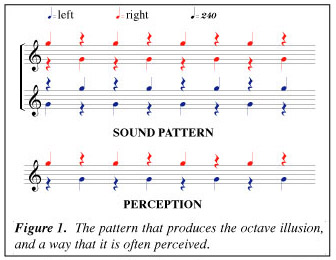 REFERENCE:
REFERENCE:
Deutsch, Diana. 2005. "Octave Illusion" Diana Deutsch. http://psy.ucsd.edu/~ddeutsch
Deutsch, Diana. 1983. "The octave illusion in relation to handedness and familial handedness background", Neuropsychologia. 21:289-293.
5. Scale Illusion
The Scale Illusion (Deutsch, Journal of the Acoustical Society of America 1975) is Psychophysical Transmission Based Auditory Illusion that exploits the Sound localisation of the Auditory Mechanism through headphone transmission manipulation.
The structure consists of 2 scales - 1ascending and 1 descending, played simultaneously with successive tones alternating between the ears.
For example, an ascending scale alternates in succession between the right and left, whilst simultaneously a descending scale alternates in succession between the left and right.
This illusion produces a number of perceptions as follows:
* The higher frequencies of the scale are perceived in one earphone, whilst the lower are perceived on the other side. Simile to the Octave illusion, when the earphones are reversed, the perception of sound localisation of the higher and lower frequencies remain the same.
* Also reflecting the octave illusion, perception appears to be related to Brain hemisphere domination and handedness. That is righthanded subjecsts with no familial lefthanded relationship exhibited the strongest perception of the higher frequencies on the right
Generation
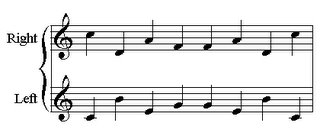
Perception
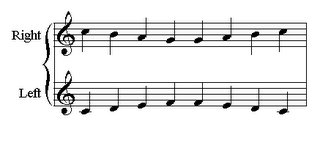
REFERENCE:
Deutsch, Diana. 1975. "Two-channel listening to musical scales", The journal of the Acoustical Society of America. 57:1156-1160.
Deutsch, Diana. 2005. "Scale Illusion" Diana Deutsch. http://psy.ucsd.edu/~ddeutsch
6. Chromatic illusion
The Chromatic Illusion is a variant of the Scale Illusion (Deutsch, Audio Magazine, 1987) that utilises a chromatic scale instead of the standard major / minor scale.
Generation 
Perception
REFERENCE:
Deutsch, Diana. 1988. " The Semitone Paradox", Music Perception. Vol. 6 2: 115—132.
Deutsch, Diana. 2005. "Chromatic Illusion" Diana Deutsch. http://psy.ucsd.edu/~ddeutsch
7. Tritone Paradox
The Tritone Paradox (Deutsch, Music Perception 1986) is a Psychophysical Transmission Based Auditory Illusion that exploits the Sound localisation of the Auditory Mechanism through multiple frequencies.
The structure involves layering a tone with multiple frequencies at octave relationships.
For example: A2 110Hz, A3 220Hz, A4 440Hz, A5 880Hz
This tone is then followed by a tone at the Augmented 4th tritone interval, that is also layered
For example: D#2 156Hz, D# 294Hz, D#3 622Hz
The subject is then to determine the direction the Augmented 4th Tritone interval has travelled, with the results of the perceptions indicating that:
* The direction of the interval was not dependent on Brain Hemisphere Domination or Musical Ability, but rather geographically. For example British and Californian subjects consistently demonstrated alternative perceptions of direction. The current theory for this result indicates the perceptions reflect speech patterns and dialects.
REFERENCE:
Deutsch, Diana. 2005. "Tritone Paradox" Diana Deutsch. http://psy.ucsd.edu/~ddeutsch
8. The Haas / Precedence Effect.
The Haas Effect (Helmut Hass Über den Einfluss eines Einfachechos auf die Hörsamkeit von Sprache, 1949) is a Psychophysical Transmission Based Auditory Illusion.
The intention of the Hass Effect is to mask one sound with another.
The structure of the illusion is based on directing two identical soundwaves of the same intensity from two independent sources: A and B. The sound generated by source A is closer to the subject than source B, therefore it arrives first. As such, the subject perceives that the sound from source A is the only sound.
REFERENCE:
Hass, Halmut. Über den Einfluss eines Einfachechos auf die Hörsamkeit von Sprache, 1949.
9. Microsounds
Microsounds (Curtis Roads) are a Psychoacoustic Construction Based Auditory Illusion that exploits the perception of the duration of time and the structure of a sound, with the actual duration in the micro time scale of less than 600ms.
Roads' approach features creating through the obtainment of microsounds particles from samples, through extensive editing and manipulation to reduce the particles to duration's not exceeding 600ms.
The result created is particles of sound too short to precisely determine the actual nature of the sound.
REFERENCE:
Roads, Curtis. 1996. The Computer Music Tutorial. Cambridge, Massachusetts: The MIT Press.
Roads, Curtis. 2001. Microsound. Cambridge, Massachusetts: The MIT Press. 86-106, 330-351.
Chowning, John. 1988."Turenas" in Digital Music Digital.
10. The Illusory Continuity of Tones
The Illusory Continuity of Tones is Psychoacoustic Construction Based Auditory Illusion that distorts the continuity, fluidity and duration of a sound.
The structure of the Auditory Illusion is based on generating a tone that is interrupted by short duration's (50ms or less) of narrow band of noise, such as White, Pink or Brown noise.
The perception created is one of fluidity and continuity of the sound, without the break or noise detected.
The stability of the tone has a small effect on the illusion, if the tone rises or falls to fast, the interval between the frequencies may be too great, thus destroying the illusion.
REFERENCE:
Yoshitaka Nakajima, Takayuki Sasaki, and Gert ten Hoopen, "Demonstrations of Auditory Illusions." http://www.kyushu-id.ac.jp/~ynhome/ENG/Demo/illusions.html

